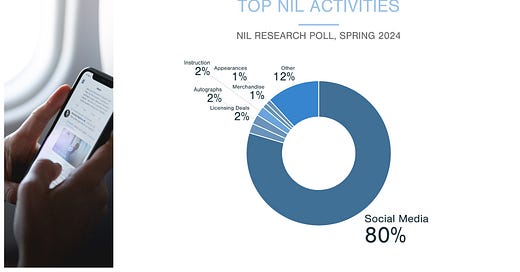It's time to double-down on student-athlete influencers
Influencer marketing is the dominant NIL activity - let's help student-athletes capitalize.
Special Announcement: I'm taking applications for the next live session of my NIL/mba Live program which will run five Wednesdays from May 15 - June 19.
This live course is for coaches, administrators, and professional service providers. Click below for info and the application. Space is limited to 10 students.
For most student-athletes, NIL is influencer marketing
80% of all NIL activity is social media influencer marketing. Let that sink in.
If you had a business where 8 out of every 10 sales was a certain kind of widget, you’d become an expert in every aspect of that widget. You’d learn how to make it fast and well. You’d promote it non-stop. You’d build an empire on that widget.
But we haven’t done that with influencer marketing as an NIL activity. I think it’s because social media influencer marketing is the everywoman/man’s NIL activity. It’s not the NIL activity of the Power Five QB, but rather the opportunity to tens of thousands of “every-day” student-athletes.
Because of that, it’s not newsworthy. But its dominance should make us reprioritize how we educate student-athletes about NIL.
We should double-down influencer marketing, starting with these four questions:
What is influencer marketing in an NIL context?
What kind of student-athletes can capitalize on the influencer marketing opportunity?
What types of businesses are utilizing student-athletes as influencers?
What can schools do to support their student-athletes in pursuit of influencer marketing opportunities?
Read below for the answers.
What is influencer marketing in an NIL context?
Influencer marketing in an NIL context is a form of social media marketing where brands collaborate with student-athletes to promote their products or services. These student-athlete influencers have established a loyal and engaged following on platforms like Instagram, YouTube, or TikTok. They are trusted sources of information within their niche.
Why does influencer marketing work?
Authenticity and Trust: Consumers are tired of traditional ads and are more likely to trust recommendations from people they admire – like their favorite student-athlete. Businesses partner with student-athletes to tap into that existing trust. 63% of consumers trust influencers' opinions on products more than brand advertising. (Nielsen) While only 4% of people trust traditional advertising. (Edelman Trust Barometer)
Targeted Reach: Student-Athlete have built a specific audience that cares about their sport, team, and daily life. By collaborating with a student-athlete, a business reaches potential customers already interested in their product.
Increased Engagement: Fans engage with student-athlete content more readily – through likes, comments, and shares. This creates a ripple effect, extending a brand's reach organically.
It's not just about the number of fans a student-athlete has, it's about the relationship they have built with their audience. That's where the true influence lies.
What kind of student-athletes can capitalize on the influencer marketing opportunity?
The short answer is, every type of student-athlete. Why? Because the influencer marketing ecosystem is relatively mature and has accounted for influencers of all shapes and sizes. Here's a detailed breakdown of influencers categorized by their follower count:
1. Nano-influencers (1,000 - 10,000 followers)
Strengths: Highly engaged audiences, niche specialization, authenticity, affordability for smaller brands.
Focus: Often hyper-focused on a particular passion.
Example: A student-athlete is a foodie with a dedicated following sharing their discoveries of restaurants in their college town.
2. Micro-influencers (10,000 - 50,000 followers)
Strengths: Blend of reach and strong engagement, perceived as trustworthy experts in their niche, a good fit for many campaigns.
Focus: More established within their niche compared to nano-influencers.
Example: A student-athlete with a passion as a makeup artist who focuses on tutorials and product reviews.
3. Macro-influencers (50,000 - 500,000 followers)
Strengths: Broad reach, ability to increase brand awareness significantly, professional-level content creation.
Focus: May cover broader lifestyle topics.
Example: A popular student-athlete who is a trusted expert on nutrition shares tips, product recommendations, and relatable healthy lifestyle content.
4. Mega-influencers (500,000+ followers)
Strengths: Massive reach, often household names, high-impact for major awareness campaigns.
Focus: Tend to be “celebrity” student-athletes with broad appeal.
Example: A Power Five QB with millions of followers marching toward the NFL draft.
Read the rest of this newsletter about the types of businesses are utilizing student-athletes as influencers and what schools do to support their student-athletes.
It’s now just $5 per month. Paid subscribers get 4 NIL/edu newsletters per month, immediate free access to the leading digital course - NIL/mba course (usually $150), and the archive of the Top 50+ most popular newsletters since 2020.
Keep reading with a 7-day free trial
Subscribe to NIL/edu to keep reading this post and get 7 days of free access to the full post archives.






